Home › Forum › Ask A Member › 1966 20HP Johnson
- This topic has 27 replies, 9 voices, and was last updated 4 years, 6 months ago by
Evinrude 25.
-
AuthorPosts
-
September 24, 2020 at 12:19 pm #217217
Hello,
I have encountered the issue and need an advice. I set up the points and got blue spare when spin the fly wheel but as soon as I torque the flywheel nut 20 ft lb. I lost spark on one spark plug. If I torque down to spec. (40 ft lb) I lost spark on both. Please let me know of what you think.September 24, 2020 at 12:24 pm #217218Did you just change points/condensers, do ignition work? Perhaps the flywheel is rubbing on some of the ignition wires under the flywheel… Tell us more about what led up to this condition…Did the engine work OK before? Did you do ignition work on the engine prior to the onset of this condition? Did you just replace the coils? Perhaps you didn’t set the air gap correctly…
September 24, 2020 at 3:30 pm #217228The whole ignition system worked before. I ran the motor a couple times. I just removed one coil and put it back the same place.The reason I removed the flywheel is to clean the point and fine tuned it. I use the ring (ID 4.468″) to line up the coils and use the multimeter for fine tuning the points. If I just put the flywheel back and tighten the nut (not much), then spin the flywheel by hand (leave the spark plug hole opened) I got strong blue spark! so I am very satisfied with it. Then I do the initial torque for 20 ft lb and check. Only one spark! Try to torque to 40 ft lb. NO SPARK! I have removed the flywheel for inspection but did not see anything wrong with it. I have worked on point/condensers of a couple motors already. You may be right about the air gap! One thing I noticed that at 20 ft lb torque, I have only one spark but the spark quality is not good. So the theory is that the more torque would push the flywheel down and create more air gap between the magnet and the coil. So today I don’t use the set up ring, just move the coil out a bit and see what happen!
September 24, 2020 at 4:40 pm #217230Not sure but in the past I used masking tape to check for rubbing. Does you motor have a removable points cam? Look to see if it is cracked maybe? Is this motor the common magneto set up? I’m lost with the newer systems. The downward pressure is changing something.
Edit: Measure resistance from plug wire to ground please, before & after tightening. I too have had problems with bad ground to block from the mag plate, Again measure resistance before & after adding a test jumper to ground. Does the plate turn easy after tightening? Did you check resistance on the points closure? Just my .02,-
This reply was modified 4 years, 7 months ago by
jeff-register.
-
This reply was modified 4 years, 7 months ago by
jeff-register.
September 25, 2020 at 9:43 am #217248Yes, this motor has a removable point cam. I have inspected it and it look good. This motor is universal magneto set up (2 coils, 2 points, 2 condensers). After tightening, the flywheel turn easily, no abnormal sound etc.
September 25, 2020 at 10:44 am #217227– There is a process for evaluating the motor. If you are willing to take guidance we can help you out to determine what is going on with your motor.
* First thing is to check the compression yourself. Most auto places will loan out a compression tester for a deposit and money is refunding when you return it. Napa, Auto Zone, O’Reilys…etc.
Here is a video to show you how you can test your compression.
https://www.youtube.com/watch?v=PyCw4SiuT2I
Please report back your finds on compression.
**Second phase of diagnostics is to evaluate the ignition.
***Third phase of diagnostics is to evaluate the ignition.By putting the spark plug against the engine block is not adequate assessment of the health of the ignition system. You need to get a spark checker and gap it to at least 1/4 inch. The spark should be able to consistently jump the gap and be strong blue snapping spark.
Here is a bunch of information that you can read and do the repairs yourself and know what is going on.
Here is some information that will help you evaluate your ignition system with the flywheel popped off.
Harmonic balance flywheel puller video
https://www.youtube.com/watch?v=Nz1st4XnsX4
Your going to need to inspect your point, condenser and coils. They are located under the flywheel. Hopefully all you need to do is clean and regap your points and you might be in business. Still check your coils and condensers and plug wires.
Here are two link to show you how to test your coils and condensers.
https://www.youtube.com/watch?v=KT8rk5QWgS0
https://www.youtube.com/watch?v=l6eSXYmENDY
How to replace your coils, points and condenser. Please take digital pictures as you go, so it will help you return everything back in the right order. Keep cheap zip lock bags available to put your parts in so you don’t lose them. They are small.
Here is a diagram of a generic OMC (Johnson/Evinrudle/Gale) ignition assembly. You will have to remove the coil designated for the top cylinder and put the oil wicker in. It should be already be coated with a very light oil. (not grease). The purpose of the oil wicker is to lightly lubricate the outside riding surface of the cam so the point shoes do not prematurely wear. If you look at the points they have little shoes that ride along the cam. Please make sure the (breaker)points cam is on the correct side or the ignition will be out of timing. It should have the word top machine written on the side facing up.
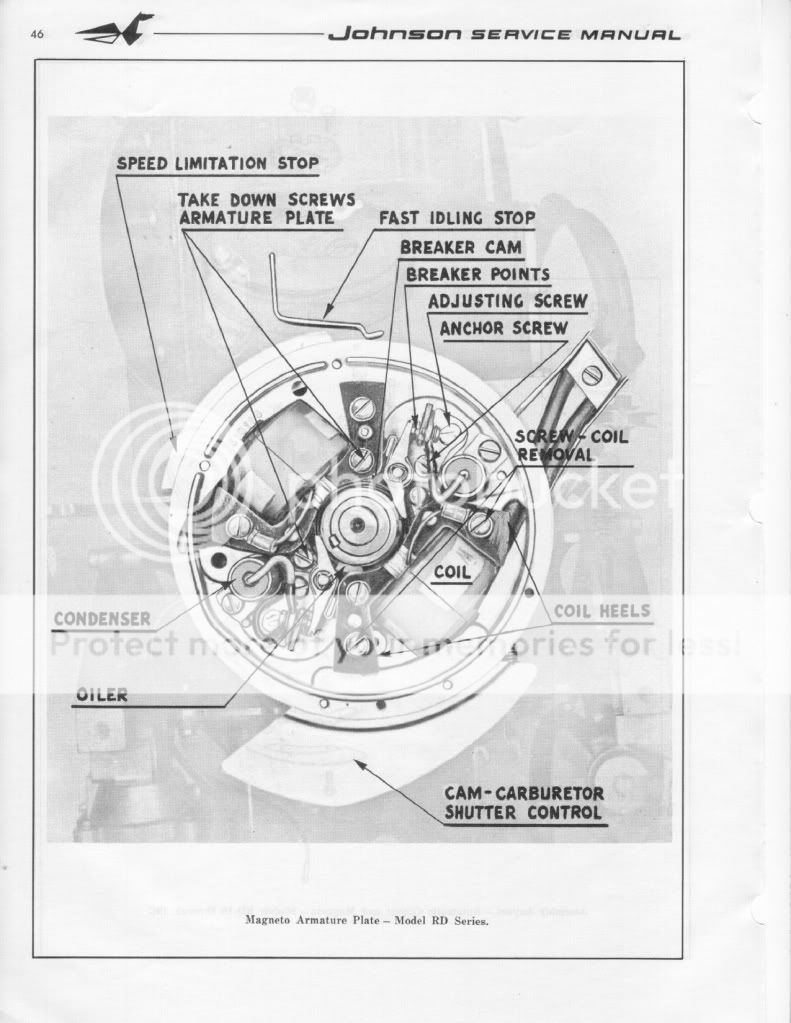
FYI: You can only set(gap) one set of points at a time. Put the flywheel nut back on(turn with a wrench or ratchet clockwise) to allow you turn the crankshaft. (Please remove both spark plugs to make it easier to turn the crankshaft and prevent accidental starting)
You gap the point to 0.020 when the point shoes is at the top(high point of the cam). It should have a mark along with the word top. Then you will turn clockwise to the next set of point 180 degrees and set those points the same way. You will notice that the point of the previous set will be closed and when you come around again they will open up. *** When they are open no current is allow through. This is how you set your timing with the points.***
When you go to set the point’s gap. Very gently snug the anchor screw, then adjust the gap with adjusting screw and the feeler gauge until the feeler gauge is sliding through with slight resistance only. Then tighten the anchor screw. Repeat procedure with second set of points. Please make sure your hands are clean and the feeler gauge is clean, because oil on the points can foul them up and create resistance….poor or no no spark. ALways use a spark check to evaluate spark. It should jump minimum 1/4 inch. Blue sharp snappy spark.
Here is a picture of a spark check…Cheap $6
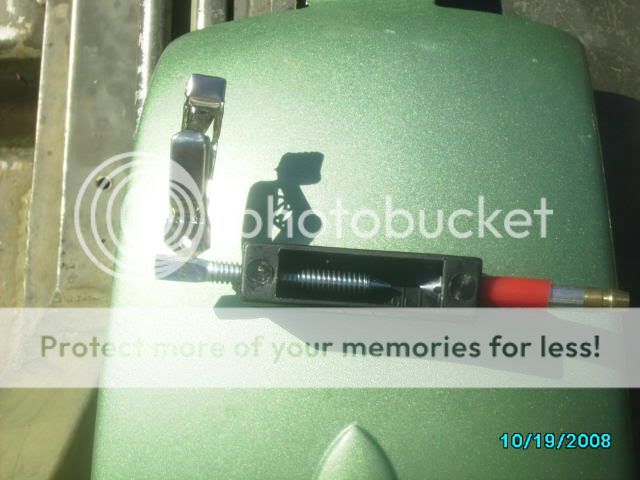
Here is a picture of how to tell which wire is going to the correct cylinder. Thanks to Garry for providing the picture on other post.
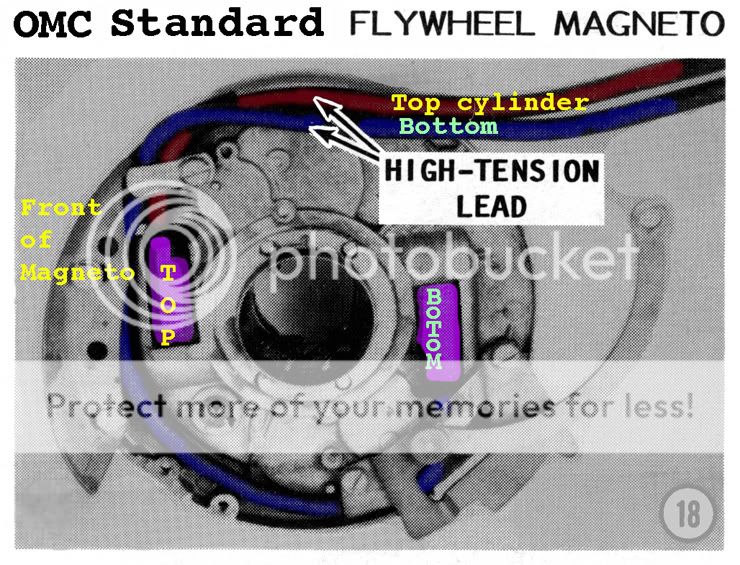
If your using the existing wires then cut about 1/4 inch of end going the coil, so you have clean un-oxidized copper contacting the spiking in the coil. Twist the end of the spark plug wire onto the coil spike. If you have replaced the wires, make sure they are 7mm copper metal core and not the automobile stuff.
***** Please make sure two things*****
1.) Make sure all the wires are tucked away under the flywheel and not rubbing up against the cam or crank, because with will eventually get damage and create a short, then no spark!!
2.) Make sure the coil heels (ends) are evenly lined up with the mounting boss.
Here are some pictures. (Compliments of JBJennings..nice fella)
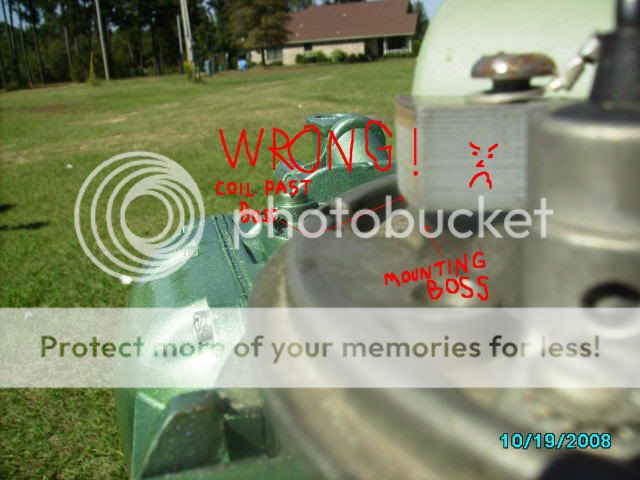
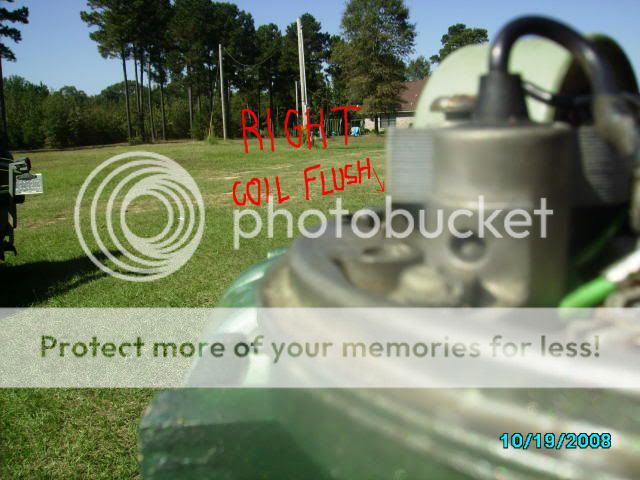
Lining up the coil heel with the mounting boss prevent damage of the coils and the flywheel magnet, prevent rubbing as the flywheel turns.
*** Make sure the throttle is advanced to that start position***
Here is another picture that Garry (thanks Garry!!) supplied on another post with some modification.
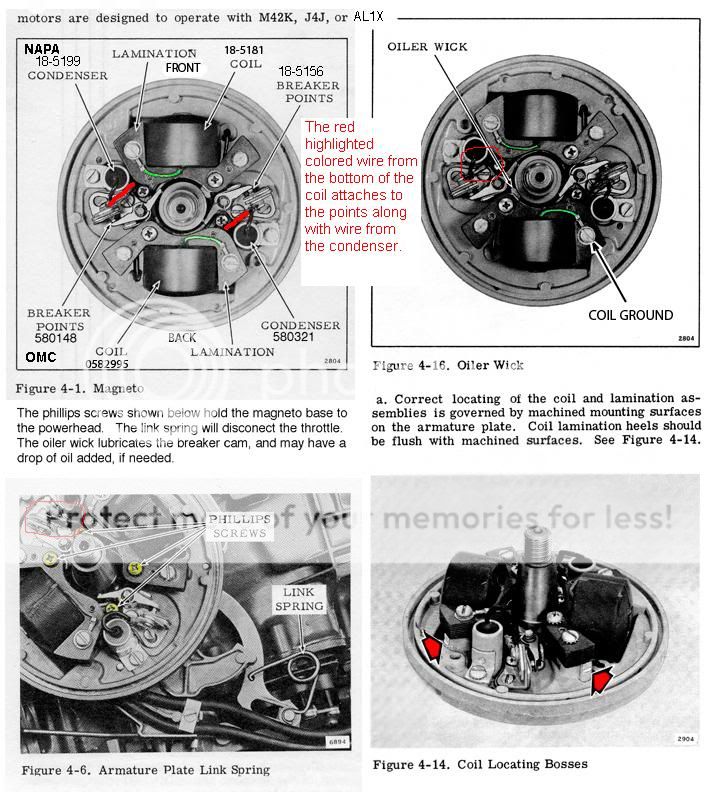
Both diagrams, should answer your questions.
Here is some you tube videos that can help you diagnosis and properly setting your ignition and clean set your carburetor
Here a bunch of videos that can help you along. They are long and detail, but I purposely made them that way, so someone new to motors would feel comfortable. So, I apologize if they are boring. I originally made those videos to help a guy who had little mechanic knowledge.
Here is a link on how to remove a flywheel.
https://www.youtube.com/watch?v=Nz1st4XnsX4
Here is a bunch of links to evaluate and repair your ignition
If your looking for a help cleaning your points and testing your ignition, then here are some YouTube videos that can help.
Not professional videos, but they can help guide you through ignition diagnostics and repair. The motor in the video is a 1968 Johnson 6hp.
Hopefully will give you a visual and help you some.
Evinrude Gale and Johnson ignition video 1
https://www.youtube.com/watch?v=oTN8Ag_aj-8
Evinrude Gale and Johnson ignition video 2
https://www.youtube.com/watch?v=r7A6d8me0Gw
Evinrude Gale and Johnson ignition video 3
https://www.youtube.com/watch?v=ZAlT32NnTJ0
Evinrude Gale and Johnson ignition video 4
https://www.youtube.com/watch?v=re6FgcB_Yok
Evinrude Gale and Johnson ignition video 5
https://www.youtube.com/watch?v=ClGt6xHnb94
Evinrude Gale and Johnson ignition video 6
https://www.youtube.com/watch?v=taaSzp1Ev-0
Evinrude Gale and Johnson ignition video 7
https://www.youtube.com/watch?v=p7w0xW48YCU
Here is a bunch of links to help you with your carburetor.Here are some videos on how to clean and apply a carburetor kit for an OMC high speed fix jet carburetor. Displayed motors are 1968 Johnson 6hp and 1964 Evinrude 18hp outboards. The videos are very long and over detailed, but I want to help those who are new/novices to motor repair. Again, I am no expert or certified marine mechanic, but I am offering video to help.
OMC fix jet carburetors part 1 of 10 (Motor displayed 1968 Johnson 6hp)
https://www.youtube.com/watch?v=7MmDOaOQyQg
OMC fix jet carburetors part 2 of 10 (Motor displayed 1968 Johnson 6hp)
https://www.youtube.com/watch?v=PuByx8J-EfY
OMC fix jet carburetors part 3 of 10 (Motor displayed 1968 Johnson 6hp)
https://www.youtube.com/watch?v=FpivbGEv0wM
OMC fix jet carburetors part 4 of 10 (Motor displayed 1968 Johnson 6hp)
https://www.youtube.com/watch?v=-aWICvsQZQ8
OMC fix jet carburetors part 5 of 10 (Motor displayed 1968 Johnson 6hp)
https://www.youtube.com/watch?v=JqB6PLqeTI4
OMC fix jet carburetors part 6 of 10 (Motor displayed 1968 Johnson 6hp)
https://www.youtube.com/watch?v=HS5J_AxJrAY
OMC fix jet carburetors part 7 of 10 (Motor displayed 1968 Johnson 6hp)
https://www.youtube.com/watch?v=Iq_2RfWjQ28
OMC fix jet carburetors part 8 of 10 (Motor displayed 1968 Johnson 6hp)
https://www.youtube.com/watch?v=-lXIVBX_UF4
OMC fix jet carburetors part 9 of 10 (Motor displayed 1968 Johnson 6hp)
https://www.youtube.com/watch?v=-nA_4YmNgt8
OMC fix jet carburetors part 10 of 10 (Motor displayed 1968 Johnson 6hp)
https://www.youtube.com/watch?v=94lcU7y2P9Y
Almost forgot to post an accessory video regarding a timing fixture. You can certain set the points with a feeler gauge as shown in the previous videos, but I just wanted to add this to the list.
https://www.youtube.com/watch?v=eNK2TEeQQv0
Carburetor Adjustment for idle/low speed needle. Your carburetor has a high speed fix jet, so no adjustment. It just needs to stay clean.
Initial setting is: Slow speed = seat gently(turn in clockwise), then open 1-1/2 turns(turn out counter clockwise). Do not tighten or force the slow idle needle shut or it may damage the needle.
Start engine and set the rpms to where it just stays running. In segments of 1/8 turns, start to turn the S/S needle valve in (clockwise). Wait a few seconds (10 to 15 sec) for the engine to respond. As you turn the valve in(clockwise), the rpms will increase. Lower the rpms again (turn your throttle slightly slower) to where the engine will just stay running.
Eventually you’ll hit the point where the engine wants to die out or it will spit back (sounds like a mild backfire). At that point, back out(turn out counter clockwise) the valve 1/4 turn. Within that 1/4 turn, you’ll find the smoothest slow speed setting.
When you have finished the above adjustment, you will have no reason to move them again unless the carburetor fouls/gums up from sitting, in which case you would be required to remove, clean, and rebuild the carburetor anyway.
September 25, 2020 at 10:44 am #217229Opps, posted more than I wanted. Oh well, pick through what you need. Sorry for the over blast. I posted that yesterday, but it didn’t show up, so I thought the format was wrong and didn’t have time to redo it all.
In the future, Im going to update or replace those videos with better footage, speaking and editing software. I used a freebie editting software and I did those videos on the fly to help a guy years ago. Just left them up on You Tube…lol
Cheers,
Cajun-
This reply was modified 4 years, 7 months ago by
 seakaye12.
seakaye12.
-
This reply was modified 4 years, 7 months ago by
cajuncook1.
September 25, 2020 at 11:49 am #217259OK, so once again, it seems like everything was OK until you pulled the flywheel and did the work… How did you get the flywheel off? What kind of puller did you use?
September 25, 2020 at 2:48 pm #217265Correct, the motor ran well. Then want to clean the points and tuned it to perfect timing as per learning from YouTube which using multimeter to set correct point gap. I use this type of puller.
-
This reply was modified 4 years, 7 months ago by
 Mumbles.
Mumbles.
September 25, 2020 at 5:58 pm #217286OK, well that puller should be OK, as long as you didn’t use a three jaw external puller….
-
This reply was modified 4 years, 7 months ago by
-
AuthorPosts
- You must be logged in to reply to this topic.


